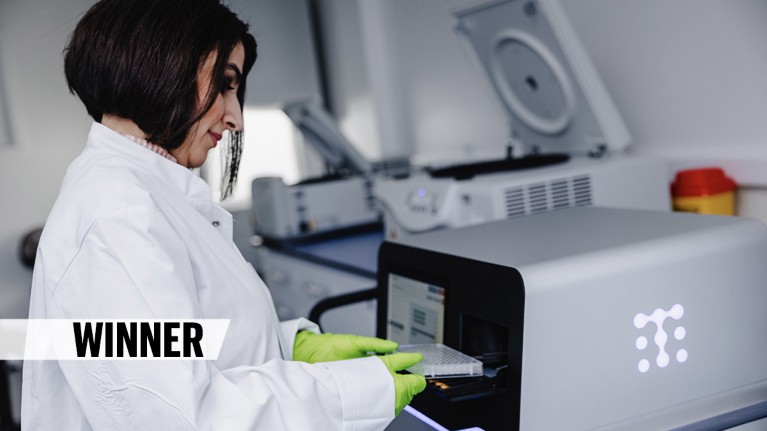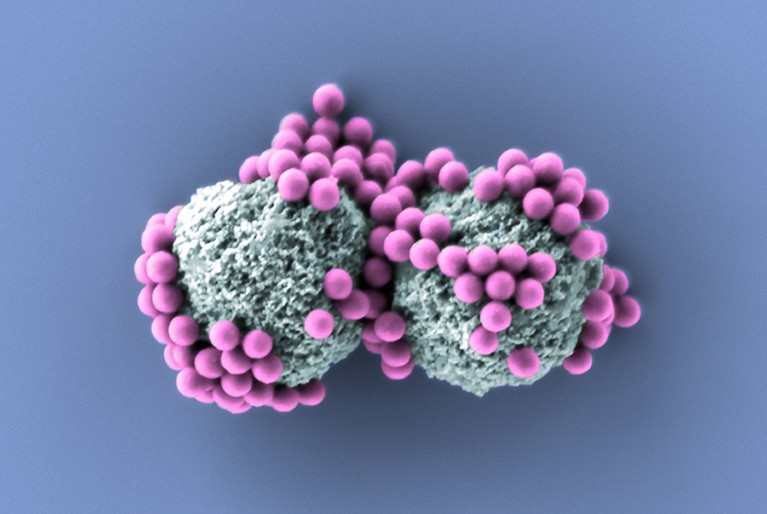
Trince’s LumiPore device allows a mix of cells, and the molecules to go inside them, to be targeted with a laser.Credit: www.fuxfotografie.be
Kevin Braeckmans has always been fascinated by light. “I started studying physics with the goal of becoming an experimental astronomer and using advanced telescopes to explore the universe,” he says. Yet, while working on his PhD, he found himself peering through microscopes instead, at “another part of the universe that was otherwise inaccessible”, says Braeckmans, who now leads the Bio-Photonic Research Group at Ghent University in Belgium.
His PhD research focused on nanomaterials for drug delivery — an endeavour that made Braeckmans realize that the approaches scientists were using to get molecules inside cells was damaging the cells. Perhaps, he thought, light might provide a gentler way of accomplishing this.
It was an idea that, in 2021, would lead to the creation of Trince — a spin-off company from Ghent University whose name is a portmanteau of ‘transfer into cells’.
Braeckmans, together with co-founders Philip Mathuis and Stefaan De Smedt, developed a device that uses a technique called photoporation to make temporary holes in the cell membrane through which molecules can make their way inside. The company’s mission is simple: to deliver almost anything into almost any type of cell, in the gentlest way possible.
Now, the potential of that has been recognized by the judges of Nature’s Spinoff Prize, who selected Trince as the most promising of all the competing companies. “They’ve built an amazing team, they’re open to mentorship, and they have the right strategy,” says judge Kiana Aran, who studies medical diagnostics and therapeutics at the Keck Graduate Institute in Claremont, California. “There is way more potential to the technology than they even have thought about,” she adds.
Quick heat
Getting a molecule inside a cell, whether for research or therapeutic purposes, is difficult to do without disrupting the cells. The large genetic constructs that are required in cancer immunotherapy and regenerative medicine pose a particular challenge.
The standard way to introduce genetic material has been with viral vectors. But that process is laborious and expensive. Moreover, the vectors can cause all sorts of trouble. They might, for example, disrupt the cell’s own genome by inserting the material in awkward places, or leave markers on the cell that activate the immune system. The viruses could even regain their capacity to reproduce, despite the process having been artificially disabled.
One vector-free approach that has emerged is electroporation, which uses an electric current to temporarily disrupt the cell membrane. This avoids the downsides of viral vectors, but it often kills many of the cells it targets. “Companies tend not to advertise how many cells survive the electroporation, but rather report on the viability of the remaining cells,” says Braeckmans.
Even among the cells that survive, there is a difference between being technically alive and being able to proliferate and perform the functions required, Braeckmans points out. Because the electrical fields used in electroporation penetrate the cells and cause damage, the cells can take several days to recover enough to start proliferating again, if they ever do, he says. “We can do better than that.”
Similar to electroporation, photoporation attempts to deliver molecules into the cell by creating tiny pores that make the cell membrane temporarily permeable. In photoporation, however, energy is absorbed not by the cell structures, but by nanoparticles added to the cell-culture medium that surrounds the cell. These are designed to heat up quickly when illuminated by extremely brief (less than 10 nanoseconds) bursts of red laser light. The effect is similar, Braeckmans says, to “how grains of sand in summer pick up sunlight and become hot”.
Depending on the amount of energy supplied by the laser, two processes can happen — both of them useful. “At lower levels,” says Braeckmans, “the heat creates temporary burn wounds in the cell membrane through which the surrounding liquid gets in.” At higher levels, the water around the particles boils, giving rise to quickly expanding bubbles that can mechanically create pores in the cell membrane.
The bubbles, which can be seen under the microscope, last only a few tens of nanoseconds (see ‘A gentle approach to poration’). But the pores they create exist for tens of seconds, which Braeckmans says “is sufficient time for the molecules to get inside”. As with electroporation, some of the cell’s contents might leak out, but photoporation does not otherwise damage the inside of the cell. As a result, more cells survive the photoporation process than make it through electroporation1.

Infographic by Alisdair Macdonald
Trince has now integrated this method into LumiPore, a device in which a cell-culture vessel, containing a mix of cells, nanoparticles and the molecules to go inside the cell, can be targeted with laser light.
“The LumiPore technology offers a safer and more versatile ‘transfection’ strategy compared to existing solutions that mostly work only for cell suspension, and it’s backed by strong preliminary studies,” says engineer Hyunwoo Yuk, one of the judges for The Spinoff Prize 2024 and co-founder of SanaHeal, which won The Spinoff Prize in 2023. He adds, however, that the field of high-throughput cell technology to introduce molecules into cells is crowded. “Many companies and start-ups have developed and commercialized competing solutions.”
So far, two LumiPore devices suitable for research have been sold. One of these was acquired by Revatis, a company based in Aye, Belgium, that produces stem cells for use in cell therapy and regenerative medicine. “We are using it for the photoporation of several molecules and genetic material into muscle-derived stem cells,” says chief executive Didier Serteyn. “It’s a gentle technology with a high percentage of living cells after incorporation.”
Trince hopes to sell at least seven more devices by the end of this year. “We are in touch with a few high-ranked academic institutes to discuss the potential of placing an instrument there that they can use to validate and conduct research with, and that they can use more or less for free for a limited amount of time,” says Jan Van Hauwermeiren, Trince’s vice-president for business development. The goal, he says, is to obtain data “to help convince other scientists”.
“Trince has been very clear about when they would become profitable, what they needed to get there and what they needed it for,” says Sue Sundstrom, founder of Sundstrom Innovation in Clevedon, UK, who chaired the Spinoff Prize judging committee.
Braeckmans hopes that the €30,000 ($32,000) prize will help to kick off the company’s first significant round of venture capital financing. “This fantastic recognition will help us to get some exposure, and to get further credibility for our company, for our technology, to secure new investments into the company,” he says.
Into the clinic
Last March, Trince received a grant from the European Innovation Council that should help the company to develop the technology for therapeutic applications, such as cancer immunotherapy and regenerative medicine, says Mathuis, the company’s chief executive. “We are now working to comply with the US Food and Drug Administration’s Current Good Manufacturing Practice regulations for medical devices,” he says.

‘Nanobombs’ could be a particularly efficient form of photoporation.Credit: Adapted from (ref to https://www.nature.com/articles/s41467-022-29713-7)
One important aspect to work out will be how to make sure that the cells being prepared for therapeutic use do not contain any of the harmful nanoparticles that were part of the photoporation process. In 2021, Braeckmans and his colleagues demonstrated1 that such particles can be embedded in nanofibres to keep them from getting into the cell. “We imagine that these fibre-embedded particles will be the central platform we will offer for cell-therapy applications, because it is safer to use,” says Braeckmans.
However, free nanoparticles are typically more effective, he says, because they can cover the entire cell surface. With that in mind, Trince is also exploring biodegradable alternatives to the iron oxide-based nanoparticles that it currently uses. These would break down after a while even if they did get into the cell. “We have a series of nanoparticles that have all been patented for our purposes, and we’re looking for the right balance between safety and efficiency,” Braeckmans says. “We’re keeping our options open.”
The company is also working to make the photoporation of cells easier and faster. For example, it is developing a device capable of photoporating cells continuously and automatically as the cells flow through it. “This would allow for full automation, which should speed things up and also help to bring the cost down,” says Mathuis.
Eventually, the device might help hospitals to engineer cells themselves, making treatments faster and more affordable. People with cancer who are awaiting T-cell treatment have absolutely no time to lose, says Braeckmans. “It’s often in the final stages of treatment that these expensive cell-based therapies are being used. So reducing those waiting times can save lives.” T cells are particularly tricky, he adds, because they are often in a dormant state. This causes problems for technologies that require the cell to actively ingest particles — but not for photoporation.
Trince is continuing to refine photoporation technology. In 2022, Braeckmans and his colleagues reported a variation of the technique — called biolistics or nanobombs — that promises to be even better at keeping cells alive2. This involves a central particle surrounded with smaller nanobullets that shoot off in all directions when the core particle is heated with pulses of laser light. For delivering large constructs into cells, this approach can be at least ten times more efficient than standard photoporation, says Braeckmans. As for what will be delivered with their tools, Trince is leaving that to others. “We are delivery guys,” Braeckmans says. “We deliver what other people develop.”
